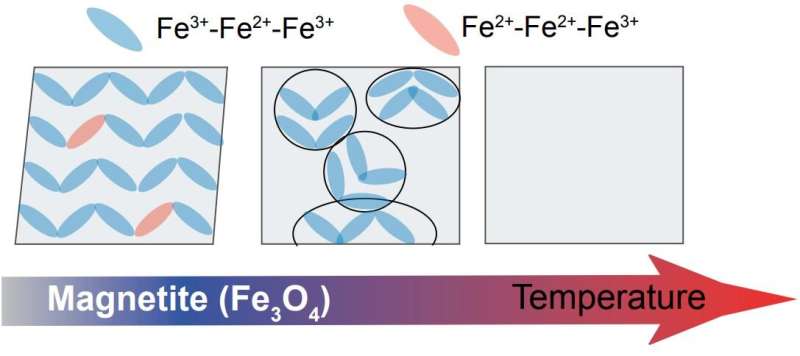Controlling self-doping in magnetite with temperature

One of the most abundant iron-containing minerals on Earth, and also the oldest known magnetic material, is magnetite, Fe3O4. Magnetite has applications in many fields, such as the study of paleomagnetism—magnetism in rocks induced at the time of their formation—medicine, and data recording. It was the first known example of a metal that transitions to an insulator, a so-called “Verwey transition,” after the Dutch chemist Evert Verwey, who first recognized the changes in the physical properties of magnetite at the transition.
This metal-to-insulator transition is found at the low-temperature of about 123 Kelvin (-150 degrees Celsius; -238 degrees Fahrenheit), a prototypical example of a “Mott insulator”–materials that are expected to conduct electricity according to conventional electronic band theories but are instead insulators.
Several decades of research have deduced that in the insulator phase of magnetite, an intricate, long-range network of linear magnetic molecules called “trimerons” form, with the linear structure Fe3+-Fe2+-Fe3+. But recently, trimerons have also been shown to exist in the high-temperature metallic-like phase, just above the Verwey transition. “However, the role of these short-range trimerons and the mechanism behind their collapse remains an unsolved puzzle,” Hebatalla Elnaggar, lead researcher of a recently published study, told Phys.org. “This motivated us to design a new experiment that addresses these questions.”
To study the collapse mechanism of the trimerons and their temperature evolution just above the Verwey transition, Elnaggar, now Rubicon Postdoctoral Fellow at Sorbonne Université in Paris and her colleagues from seven other universities and institutions, subjected a magnetite crystal to high-energy X-rays at the European Synchrotron Radiation Facility in Grenoble, France. Using X-ray spectroscopy, they were able to investigate the short-range structural fluctuations and charge reordering in magnetite.
“We discovered that a new charge reordering occurs in the metallic-phase leading to a hole self-doping effect at the Fe3+-Fe2+-Fe3+ trimeron unit,” Elnaggar said. “Doping” a material usually means adding an extra chemical species to change the material’s electrical or optical property–the best known example is adding impurities to a semiconductor like silicon to change its ability to conduct electricity. With “self-doping,” magnetite by itself increases the number of Fe3+ ions with respect to the Fe2+ ions when the temperature is increased, and this has a significant effect on the trimerons.
“In this paper, we show how this ratio can map the temperature dependence of important physical properties as electrical conductivity and magnetism,” said Elnaggar.
Moreover, the group found that the level of self-doping can be continuously and reversibly tuned by controlling the temperature. They also identified three temperature domains, or regimes, of self-doping that describe the temperature dependence of key physical properties of magnetite such as electrical conductivity and magnetism. The short-range trimerons act as a “descriptor of correlations”—they describe the evolution of electrical and magnetic properties in magnetite and their collapse due to the temperature-driven hole self-doping.
The three charge-ordering regimes match the known temperature evolution of key physical properties of magnetite “exquisitely well,” the team wrote in their paper—from below the Verwey transition at 123 K to semiconductor-like behavior up to 330 K, followed by a decrease in conductivity with temperature typical of metal-like behavior to 840 K, followed by a modest rise of conductivity with temperatures above 840 K, marking the onset of the third regime.
Thus, the temperature-driven self-doping provides a unique, adjustable handle that is closely and intimately connected to chemical doping.
“Our results provide an elegant analogy between the effect of chemical doping and temperature-driven self-doping in magnetite and inspires us to ask: Can this analogy be generalized to other Mott insulators?” Elnaggar said. (Other well-known examples of Mott insulators are nickel oxide, NiO, and lanthanum copper oxide, La2CuO4, the latter being a superconductor at about 40 K.)
Because this technique uses hard X-ray inelastic scattering (“inelastic” meaning the energy of the incoming X-ray photon changes), this experiment can be applied under high pressure and high temperatures. “This opens up exciting research possibilities in the field of earth science and phase transitions under extreme conditions,” said Elnaggar, where understanding correlations in iron minerals under high pressures and temperatures is essential.
“We envision that this technique can solve open questions in paleomagnetism such as understanding the magnetic structure of titanomagnetites under high pressure,” Elnaggar said. Paleomagnetism is the study of the Earth’s locked-in record of past magnetic fields—intensity and direction—in rocks and other materials; it can provide information about the location of tectonic plates and geomagnetic field reversals, among other information. Titanomagnetite is a mineral containing oxides of titanium and iron—a titanium-rich magnetite in which Ti2+ replaces some of the Fe2+. Titanomagnetites are common magnetic minerals in igneous rocks (rocks formed when hot, molten rock crystallizes and solidifies) and metamorphic rocks (changed by heat and pressure deep within the earth’s crust), also important to the study of geomagnetism.
The research was published in Physical Review Letters.
Magnetite nanowires with sharp insulating transition
Hebatalla Elnaggar et al, Temperature-Driven Self-Doping in Magnetite, Physical Review Letters (2021).
DOI: 10.1103/PhysRevLett.127.186402
© 2022 Science X Network
Citation:
Controlling self-doping in magnetite with temperature (2022, January 5)
retrieved 5 January 2022
from https://phys.org/news/2022-01-self-doping-magnetite-temperature.html
This document is subject to copyright. Apart from any fair dealing for the purpose of private study or research, no
part may be reproduced without the written permission. The content is provided for information purposes only.
For all the latest Science News Click Here
For the latest news and updates, follow us on Google News.

